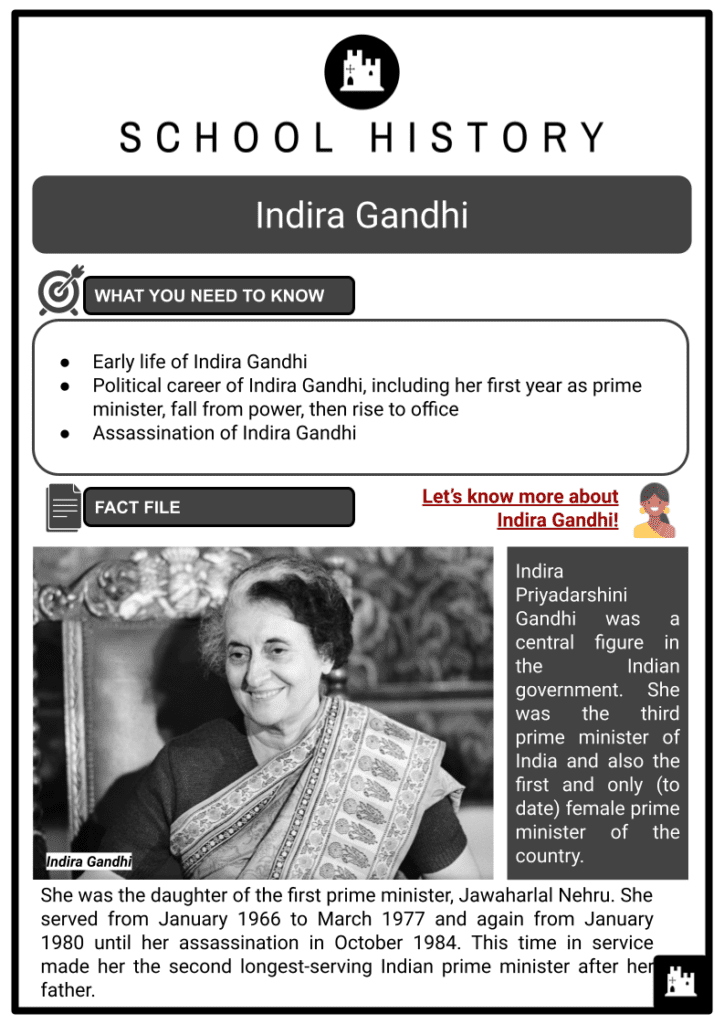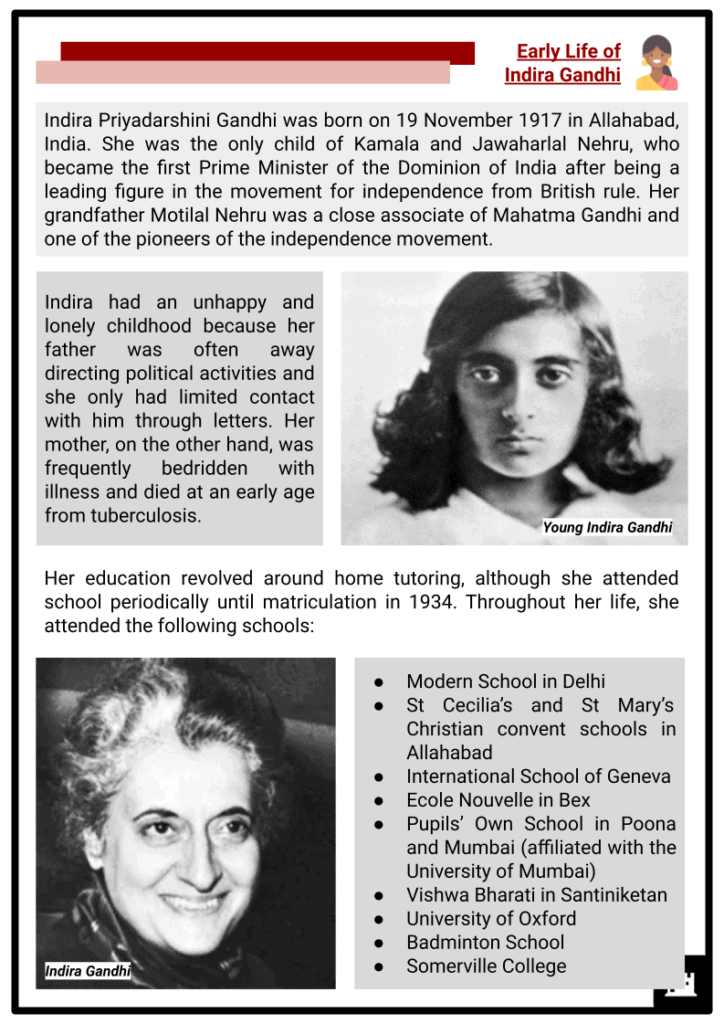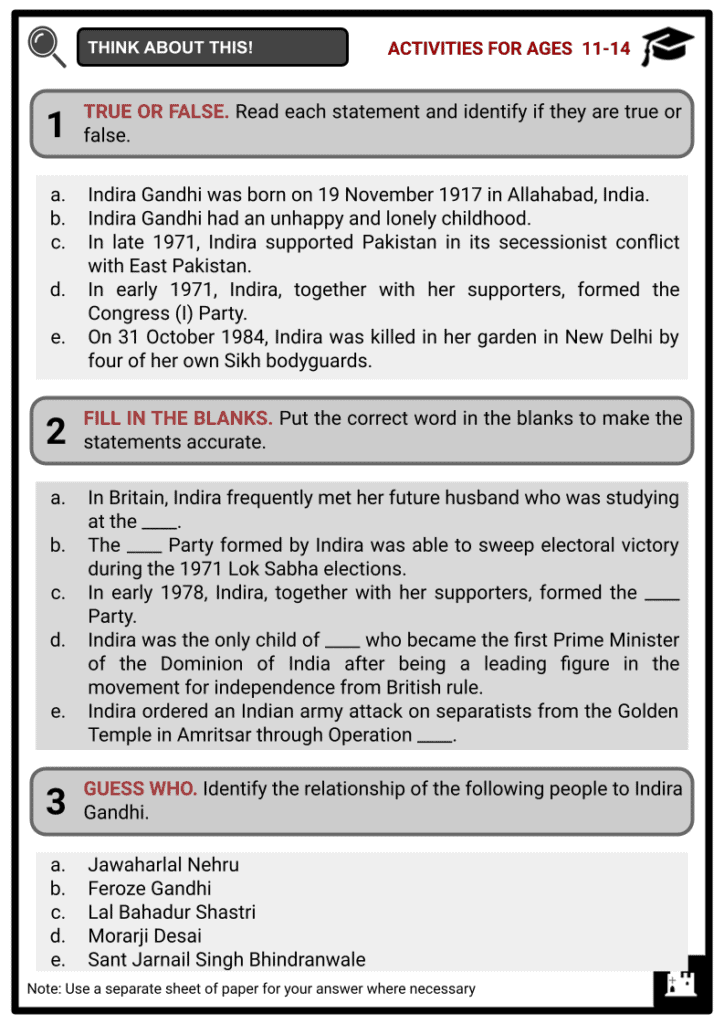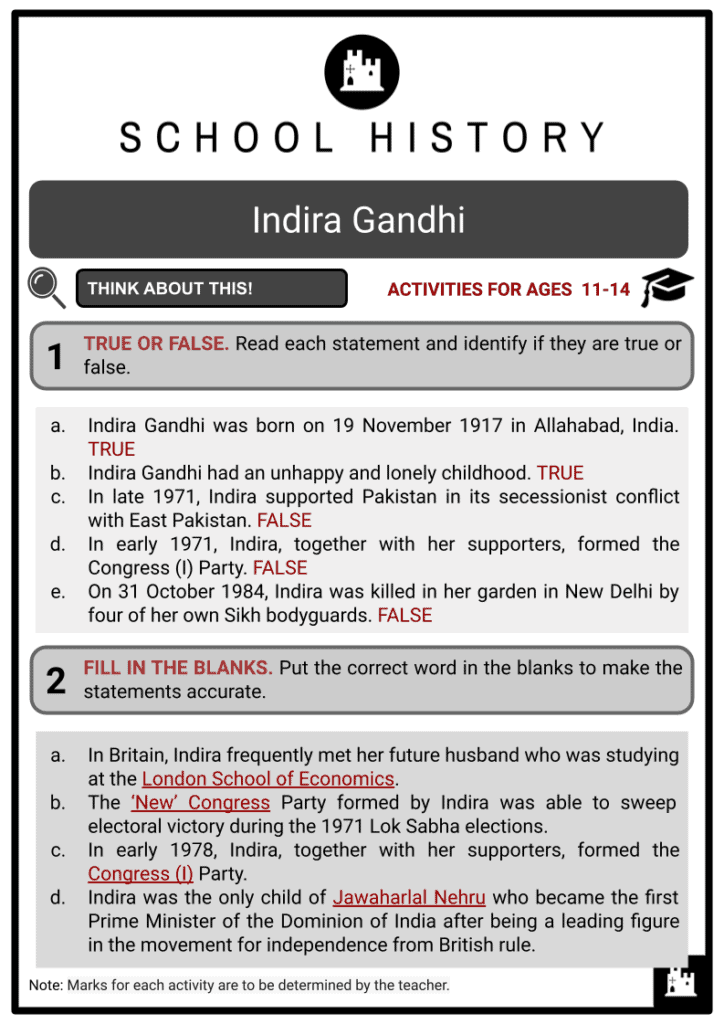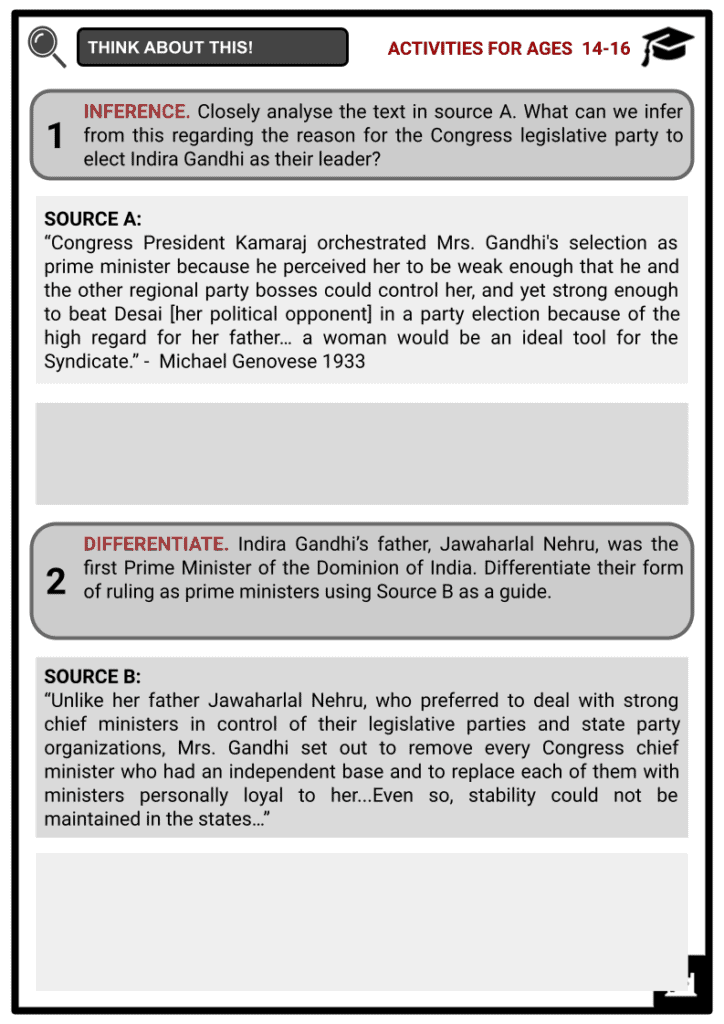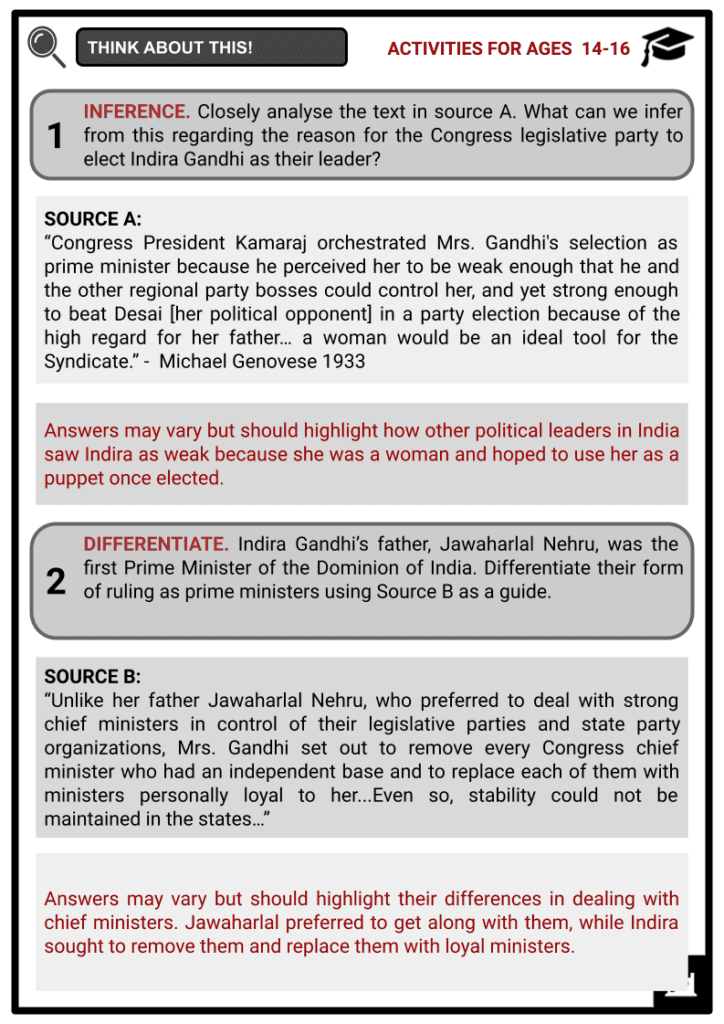Download Indira Gandhi Worksheets
Do you want to save dozens of hours in time? Get your evenings and weekends back? Be able to teach about Indira Gandhi to your students?
Our worksheet bundle includes a fact file and printable worksheets and student activities. Perfect for both the classroom and homeschooling!
Summary
- Early life of Indira Gandhi
- Political career of Indira Gandhi, including her first year as prime minister, fall from power, then rise to office
- Assassination of Indira Gandhi
Key Facts And Information
Let’s know more about Indira Gandhi !
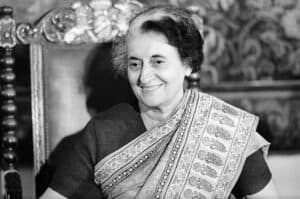
Indira Priyadarshini Gandhi was a central figure in the Indian government. She was the third prime minister of India and also the first and only (to date) female prime minister of the country.
She was the daughter of the first prime minister, Jawaharlal Nehru. She served from January 1966 to March 1977 and again from January 1980 until her assassination in October 1984. This time in service made her the second longest-serving Indian prime minister after her father.
Early Life of Indira Gandhi
- Indira Priyadarshini Gandhi was born on 19 November 1917 in Allahabad, India. She was the only child of Kamala and Jawaharlal Nehru, who became the first Prime Minister of the Dominion of India after being a leading figure in the movement for independence from British rule. Her grandfather Motilal Nehru was a close associate of Mahatma Gandhi and one of the pioneers of the independence movement.
- Indira had an unhappy and lonely childhood because her father was often away directing political activities and she only had limited contact with him through letters. Her mother, on the other hand, was frequently bedridden with illness and died at an early age from tuberculosis.
- Her education revolved around home tutoring, although she attended school periodically until matriculation in 1934. Throughout her life, she attended the following schools:
- Modern School in Delhi
- St Cecilia’s and St Mary’s Christian convent schools in Allahabad
- International School of Geneva
- Ecole Nouvelle in Bex
- Pupils’ Own School in Poona and Mumbai (affiliated with the University of Mumbai)
- Vishwa Bharati in Santiniketan
- University of Oxford
- Badminton School
- Somerville College
- In Britain, Indira frequently met her future husband, Feroze Gandhi, who was studying at the London School of Economics. The two got married in Allahabad in 1942 and later had two sons, Rajiv (1944) and Sanjay Gandhi (1946).
- After Indira’s marriage, she served as a personal assistant to her father during his tenure as the first prime minister of India. In 1959, she was elected party president and was made a member of the upper chamber of the Indian parliament, Rajya Sabha, five years later. In the same year, succeeding prime minister (after the death of Indira’s father), Lal Bahadur Shastri, named Indira the minister of information and broadcasting in his government.
Political Career: First Period as Prime Minister
- In January 1966, Shastri’s sudden death made Indira leader of the Party, thus leading to her becoming the next prime minister after a compromise between the party’s left and right wings. However, her leadership became quite a challenge because of the right wing former minister of finance, Morarji Desai.
- Though Indira won a seat during the 1967 Lok Sabha (lower chamber of the Indian parliament) elections, the Congress party was only able to win a few seats and so Indira had to accept Desai as deputy prime minister. Tensions grew more within the party and by 1969, Indira was expelled from the party by Desai.
- Nonetheless, Indira, together with a majority of party members, formed a new faction called the ‘New’ Congress Party. The party was able to sweep electoral victory during the 1971 Lok Sabha elections.
- In late 1971, Indira supported East Pakistan (now Bangladesh) in its secessionist conflict with Pakistan. India’s armed forces achieved a decisive victory over Pakistan, which earned them the creation of Bangladesh. Indira became the first government leader to recognise the new country.
- March 1972 saw more successes for the New Congress Party as the group managed to have landslide victories in a large number of elections to state legislative assemblies. However, the celebrations were short-lived as the defeated party from the 1971 national election charged her for violating election laws.
- June 1975 saw the High Court of Allahabad ruling against Indira. This required her to stay out of politics for six years and deprived her of her seat in parliament. Although she appealed to the Supreme Court, she wasn’t given a satisfactory response. So she declared a state of emergency throughout India that assumed emergency powers and imprisoned her party rivals.
Political Career: Fall from Power
- Public opposition to Indira’s emergency rule rose. After it ended in early 1977, political rivals were determined to oust her and the New Congress Party from power. This resulted in their massive defeat during the 1977 national parliamentary elections. The Janata Party then took over the government with Desai as prime minister. Indira was briefly imprisoned on charges of official corruption.
Rise to office
-
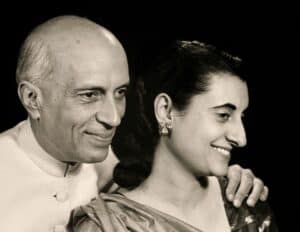
Jawaharlal Nehru and his daughter Indira Gandhi In early 1978, Indira, together with her supporters, formed the Congress (I) Party (‘I’ for Indira). In November 1978, she won a new seat in the Lok Sabha, which strengthened the Congress (I) Party.
- Due to the divide within the Janata Party, its government fell in August 1979 and when new elections were held the year after, Indira and Congress (I) won by a landslide. All legal cases against Indira were now withdrawn. When Indira’s son and successor, Sanjay, died suddenly in a plane crash in June 1980, Indira had to groom her other son, Rajiv, to lead the party.
Assassination
- Indira faced threats to the political integrity of India in the early 1980s. A number of states sought more independence from the central government. Sikh separatists used violence to assert their demands for an autonomous state.
-
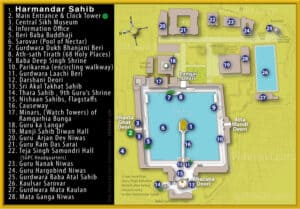
Map of the Golden Temple complex In 1982, Sikhs led by Sant Jarnail Singh Bhindranwale occupied the Sikhs’ holiest shrine, the Golden Temple at Amritsar. Tensions escalated between the group and the government, which led Indira to order an Indian army attack on separatists from the temple through Operation Blue Star. Buildings in the shrine were damaged and at least 450 Sikhs died.
- On 31 October 1984, Indira was killed in her garden in New Delhi by two of her own Sikh bodyguards who sought retribution for the attack in the temple. Her son, Rajiv, succeeded as prime minister until 1989.
Image Sources
- https://www.thoughtco.com/thmb/ikV41tCmvKVFeCCHA8RS8hKXD2Y=/3543x2349/filters:fill(auto,1)/IndiraGandhi1983HultonGetty-56a042a63df78cafdaa0b882.jpg
- https://api.operanationaldurhin.eu/assets/w800-h800-q80-p1/a6e89be1/nehru_indira_gandhi.jpg
- https://upload.wikimedia.org/wikipedia/commons/d/d8/New--Plan-of-Harmandar-rp.jpg

